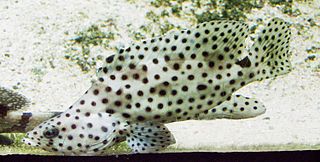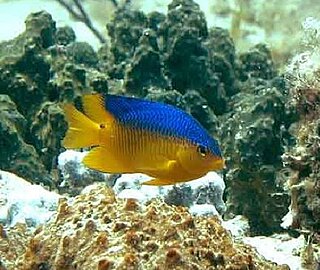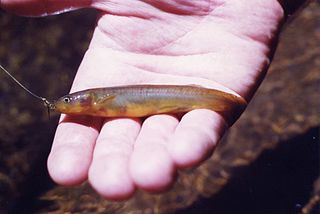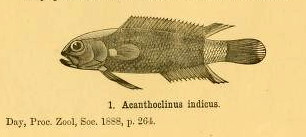
The Serranidae are a large family of fishes belonging to the order Perciformes. The family contains about 450 species in 65 genera, including the sea basses and the groupers. Although many species are small, in some cases less than 10 cm (3.9 in), the giant grouper is one of the largest bony fishes in the world, growing to 2.7 m in length and 400 kg (880 lb) in weight. Representatives of this group live in tropical and subtropical seas worldwide.

Pomacentridae is a family of ray-finned fish, comprising the damselfishes and clownfishes. This family were formerly placed in the order Perciformes but are now regarded as being incertae sedis in the subseries Ovalentaria in the clade Percomorpha. They are primarily marine, while a few species inhabit freshwater and brackish environments. They are noted for their hardy constitutions and territoriality. Many are brightly colored, so they are popular in aquaria.

Requiem sharks are sharks of the family Carcharhinidae in the order Carcharhiniformes. They are migratory, live-bearing sharks of warm seas and include such species as the tiger shark, bull shark, lemon shark, spinner shark, blacknose shark, blacktip shark, grey reef shark, blacktip reef shark, silky shark, dusky shark, blue shark, copper shark, oceanic whitetip shark, and whitetip reef shark.
The eelpouts are the ray-finned fish family Zoarcidae. As the common name suggests, they are somewhat eel-like in appearance. All of the roughly 300 species are marine and mostly bottom-dwelling, some at great depths. Eelpouts are predominantly found in the Northern Hemisphere. The arctic, north pacific and north Atlantic oceans have the highest concentration of species, however species are found around the globe.

Combtooth blennies are blenniiformids; percomorph marine fish of the family Blenniidae, part of the order Blenniiformes. They are the largest family of blennies with around 401 known species in 58 genera. Combtooth blennies are found in tropical and subtropical waters in the Atlantic, Pacific and Indian Oceans; some species are also found in brackish and even freshwater environments.

The Carangidae are a family of ray-finned fish that includes the jacks, pompanos, jack mackerels, runners, trevallies, and scads. It is the largest of the six families included within the order Carangiformes. Some authorities classify it as the only family within that order but molecular and anatomical studies indicate that there is a close relationship between this family and the five former Perciform families which make up the Carangiformes.

The Galaxiidae are a family of mostly small freshwater fish in the Southern Hemisphere. The majority live in Southern Australia or New Zealand, but some are found in South Africa, southern South America, Lord Howe Island, New Caledonia, and the Falkland Islands. One galaxiid species, the common galaxias, is probably the most widely naturally distributed freshwater fish in the Southern Hemisphere. They are coolwater species, found in temperate latitudes, with only one species known from subtropical habitats. Many specialise in living in cold, high-altitude upland rivers, streams, and lakes.

Ephippidae is a family of percomorph fishes, the spadefishes, in the order Moroniformes. These fishes are found in the tropical and temperate oceans of the world, except for the central Pacific.

Stichaeidae, the pricklebacks or shannies, are a family of marine ray-finned fishes in the suborder Zoarcoidei of the order Scorpaeniformes. Most species are found in the North Pacific Ocean with a few in the North Atlantic Ocean.

Lutjanidae, or snappers are a family of perciform fish, mainly marine, but with some members inhabiting estuaries, feeding in fresh water. The family includes about 113 species. Some are important food fish. One of the best known is the red snapper.

Pterygotrigla is a genus of genus of marine ray-finned fishes belonging to the family Triglidae, the gurnards and sea robins, one of two genera belonging to the subfamily Pterygotriglinae. These gurnards are found in the Indian and Pacific oceans.

Pseudoblennius is a genus of marine ray-finned fishes belonging to the family Cottidae, the typical sculpins. These fishes are found in the northwestern Pacific Ocean.

Neosebastinae, the gurnard scorpionfishes or gurnard perches, is a small subfamily of deep-sea ray-finned fishes, it is part of the family Scorpaenidae. These fishes are found in the Indian and Pacific oceans. Several of the species in this family are venomous.

Kyphosus is a genus of sea chubs native to the Atlantic, Indian and Pacific oceans. It is the only genus in the subfamily Kyphosinae of the family Kyphosidae.

Notograptus is a genus of marine fish in subclass Actinopterygii and order Perciformes. They are sometimes placed in a family of their own, Notograptidae, or may instead be included in the family Plesiopidae. Notograptus supposedly bears a relationship with Acanthoplesiops.

The Acanthoclininae is a subfamily of ray-finned fishes, one of two in the family Plesiopidae. They are characterised by the head being scaleless or nearly scaleless, a dorsal fin which has 17–26 spines and 2–6 soft rays, an anal fin having 7–16 spines and 2–6 soft rays while the pelvic fin has one spine and two soft rays. There are between one and four lateral lines, the number of vertebrae is between 26 and 35. They grow to a maximum length about 30 centimetres (12 in).

Plesiopinae is one of two subfamilies in the family Plesiopidae, the longfins or roundheads.

Assessor is a genus of ray-finned fishes which belong to the longfin family Plesiopidae. They are found in the western Pacific Ocean from Japan to Australia.

Paradicichthyinae is a subfamily of marine ray-finned fishes, one of four subfamilies classified within the family Lutjanidae, the snappers.
Gymnelinae is a subfamily of marine ray-finned fish belonging to the family Zoarcidae, the eelpouts. Most species are found in the North Pacific Ocean but one genus is cosmopolitan, and another is endemic to the Southern Ocean.




















